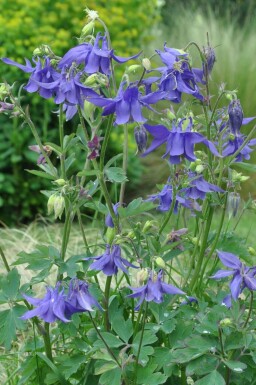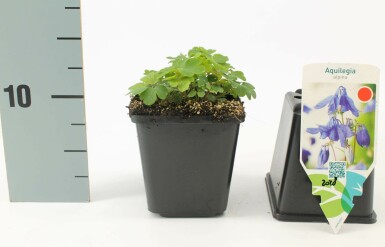

40cm




Nestled within the majestic Alps and Northern Italy, the Aquilegia, or columbine, is a perennial that graces gardens with its distinct nodding flowers. This enchanting genus, with blooms in hues of blue, purple, and white, is a testament to nature's artistry. The foliage of the Aquilegia is equally attractive, showcasing a palette of green and grey that complements its delicate blossoms. Although this species does not bear fruit and is not known for being fragrant, its ethereal beauty makes it a cherished addition to any garden space, where its elegance and charm can be appreciated throughout its blooming season.


40cm






20cm







70cm



The genus Aquilegia, commonly known as columbine, is a charming group of flowering perennials renowned for their distinctive, bell-shaped flowers and lacy foliage. Native to mountainous regions such as the Alps and parts of Northern Italy, Aquilegia thrives in a variety of climates, gracing garden borders with its delicate beauty. The columbine's flowers are not only a visual delight but also attract pollinators like hummingbirds and butterflies to the garden, creating a vibrant and ecologically beneficial environment.
Aquilegia plants are recognized for their unique and enchanting blooms that appear in late spring to early summer, showcasing a palette of blue, purple, and white hues. Their foliage, which can range from green to blue-green and even grey or silver, adds textural interest to the garden throughout the growing season.
Key features of Aquilegia include:
For gardeners looking to add Aquilegia to their landscape, here are some helpful tips for cultivation and maintenance:
With its delightful blooms and graceful foliage, Aquilegia adds a touch of alpine elegance to any garden setting, offering a picturesque display that bridges the gap between spring and summer.
Embrace the enchanting beauty of the columbine, a treasure trove of delicate blooms that dance atop slender stems, swaying gracefully in the gentlest of breezes. Their captivating, nodding flowers, intricate and diverse, evoke a sense of whimsy in any garden setting. Whether nestled in the dappled shade or basking in the soft morning light, these perennials bring a touch of alpine magic and old-world charm to your outdoor sanctuary.
We would like to provide some tips on how to plant and care for a Aquilegia. By following these tips, you can be sure to enjoy your Aquilegia for a long time.
For optimal growth, Aquilegia flourishes in locations that receive full sun to partial shade. It is adaptable to various soil types, provided they are well-drained. Aiming for a spot that offers morning sunlight with afternoon shade can contribute to the vibrancy of its blooms and help maintain the lushness of its foliage. The plant's natural alpine origins suggest a preference for cooler conditions, so in regions with intense heat, a shadier position is beneficial to prevent stress. Ensuring an average water supply will support its clump-forming and ascending growth habit, keeping it healthy and vigorous throughout its blooming season.
When planting Aquilegia, select a location that enjoys either full sun or partial shade to accommodate its preference for light conditions. The soil should be of any type but must be well-drained to promote healthy growth. As these plants are typically pot-grown, they can be introduced into your garden throughout the growing season, though the optimal times are in the spring or autumn. Ensure adequate spacing between plants to allow for their clump-forming habit. Regular watering after planting is crucial to help establish the root system, though be mindful not to overwater to prevent root rot.
To ensure the Aquilegia thrives, it is important to provide it with the appropriate nutrients. Fertilize using a balanced, all-purpose granular fertilizer early in the growing season to encourage healthy foliage and vibrant blooms. Apply the fertilizer according to the package instructions, typically once in the spring as new growth appears.
Avoid over-fertilization, as this can lead to excessive foliage at the expense of flower production. A moderate application will suffice, considering Aquilegia's average nutritional requirements. Well-drained soil is ideal for these plants, and they can adapt to a range of soil conditions, provided they are not waterlogged. Regular feeding, coupled with the natural richness of the soil, will help maintain the ornamental appeal of these perennials through their blooming months.
Aquilegia thrives with minimal intervention, making it a low-maintenance choice for gardeners. Although it is generally not necessary to prune this species, spent flowers can be deadheaded to encourage additional blooms and prevent self-seeding if desired. At the end of the blooming season, the foliage can be cut back to the ground to keep the area tidy. This will also allow for a fresh flush of leaves the following spring. Remember, however, that the plant will naturally die back as it is deciduous.
To ensure the flourishing of Aquilegia, maintaining evenly moist soil is essential. It prefers well-drained ground that receives regular watering, particularly during periods of growth and bloom in May and June. Care should be taken to avoid waterlogging, as this species thrives in conditions where moisture is present without being excessive. During extended dry spells, supplemental watering will support the plant's health and sustain the vibrancy of its blue, purple, and white blossoms. Adequate hydration is particularly crucial when Aquilegia is grown in full sun, requiring more frequent watering than those positioned in partial shade.
Aquilegia thrives when given the chance to naturalize, filling garden spaces with its graceful foliage and nodding blooms. This species benefits greatly from mulching, which helps maintain soil moisture and temperature. Moreover, the Aquilegia's self-seeding ability ensures a delightful resurgence of blossoms year after year without additional effort. It's worth noting that the plant's delightful flowers are a favorite for creating charming and whimsical cut flower arrangements.
To propagate Aquilegia and maintain its health, division is recommended. This involves carefully lifting the clump from the soil and separating it into smaller sections, each with a portion of the root system intact. Ideally, this should be carried out in the milder conditions of spring or autumn to allow the plants to establish in their new location before the extremes of summer heat or winter cold. Once divided, replant the sections promptly, ensuring they are placed in well-drained soil and have adequate space for growth. This technique rejuvenates the plant and encourages a robust display of flowers in the following season.
Aquilegia, with its distinctive, graceful flowers and fern-like foliage, is an enchanting addition to any garden. This plant, also known as Columbine, offers a delightful assortment of color and form, attracting pollinators and providing a charming backdrop for your outdoor space. Its easy-going nature makes it a gardener's favorite.
